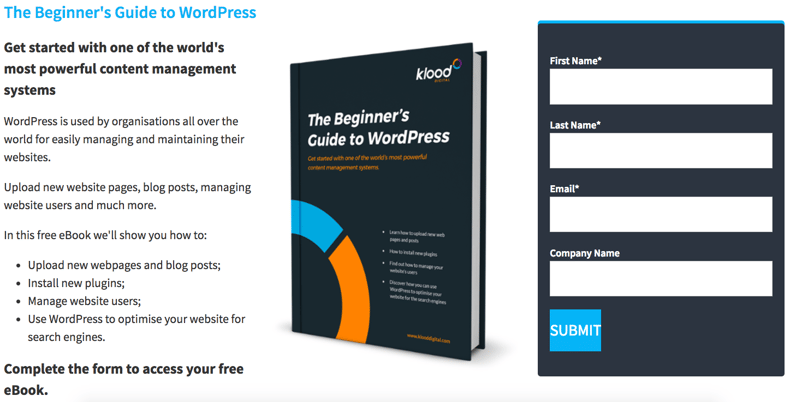
Get weekly
HubSpot updates
The key is to not just churn out article after article and hope that the sheer volume of content will get your numbers up, but to make sure you’re addressing common questions and challenges faced by your target audience.
Once you’ve developed a comprehensive content calendar and started to publish articles regularly, you’ll hopefully start to see those traffic numbers steadily rise - but how do you take advantage of that increase in traffic? This is where content gating comes in.
What is ‘gated content’?
Simply put, gated content is a guide, eBook, whitepaper or similar offer that sits behind a registration form.Here’s an example of one of our pieces of gated content, The Beginner’s Guide to WordPress:

To access this eBook you have to provide your name and email address (company name is optional).
Once this form has been submitted the user is taken through to a thank you page from where they can download the content.
We’d recommend against making these registration forms too long. The more fields the user is required to fill out, the more likely they are to be put off by the amount of information they are required to provide, or simply by the length of time it’ll take. A study conducted by MarketingExperiments.com found that conversion rates dropped and cost-per-lead increased as form length increased.
The benefits of gating your content
There are a wide range of benefits to providing gated content on your website, and primarily they centre around lead generation.Capture more leads
If people are visiting your website and consuming your content that’s great but, without a method of capturing them as a lead, once they leave the website they’ve disappeared into the ether, leaving only one extra digit in the ‘Views’ column within Google Analytics.Gating that content ensures you can capture their name, email address, phone number - whatever information you think will be valuable.
Easier to segment your leads
As well as helping you to generate more leads, the information you acquire through your registration forms allows you to segment those leads based on what subject areas they’ve expressed an interest in.For example, if a company that specialises in supplying and installing kitchens and bathrooms offers an eBook titled ‘The Complete Guide to Choosing the Right Shower Unit’, they’ll know that anyone who downloads that is interested in a new shower - and possibly even a brand new bathroom.
‘Exclusivity’ value
We all love getting something for free, but we also love getting hold of things that have an air of exclusivity around them too.By gating your content you can give the impression that it is not something everyone can readily access (even if the registration form is open to anyone). Don’t forget though, this isn’t going to work unless your content offer sounds like it’s worth downloading in the first place.
Striking the right balance
So if gating your content helps you to convert more of your website traffic into leads, does that mean you should be gating all of your content?
The short answer is no.
First of all, gated content cannot be crawled by search engines and, therefore, offers limited SEO value compared with non-gated content. If you gate the whole lot, as far as Google’s concerned you’re barely producing any fresh content at all.
Secondly you need to bear in mind that not everyone is that keen to hand over their personal information. You don’t want to completely shut yourself off from those website visitors that are simply never going to download a piece of gated content.
It’s all about striking the right balance between the two.
Here at SpotDev we offer a range of downloadable content offers while still producing regular, free content on our blog. For example, The Beginner’s Guide to WordPress and The Guide to Running an Inbound Marketing Campaign are both pieces of gated content, whereas A Beginner’s Guide to Google Tag Manager and The Beginner’s Guide to Photoshop are both free-to-access blog posts.
It’s important to provide enough free content so that people can see that you’re producing quality articles without the need to give anything away.
You can identify what the best course of action is by thinking about what you want the content to achieve, and indeed what you think it can achieve.
A simple how to guide isn’t going to be downloaded if there are dozens of free alternatives out there, but if you’re providing some genuine and unique value then this is the sort of thing that will help to drive leads.
Unsure of how to actually gate your content? Download our free eBook, The Guide to Running an Inbound Marketing campaign to learn all about creating your first landing pages, thank you pages and calls-to-action.

